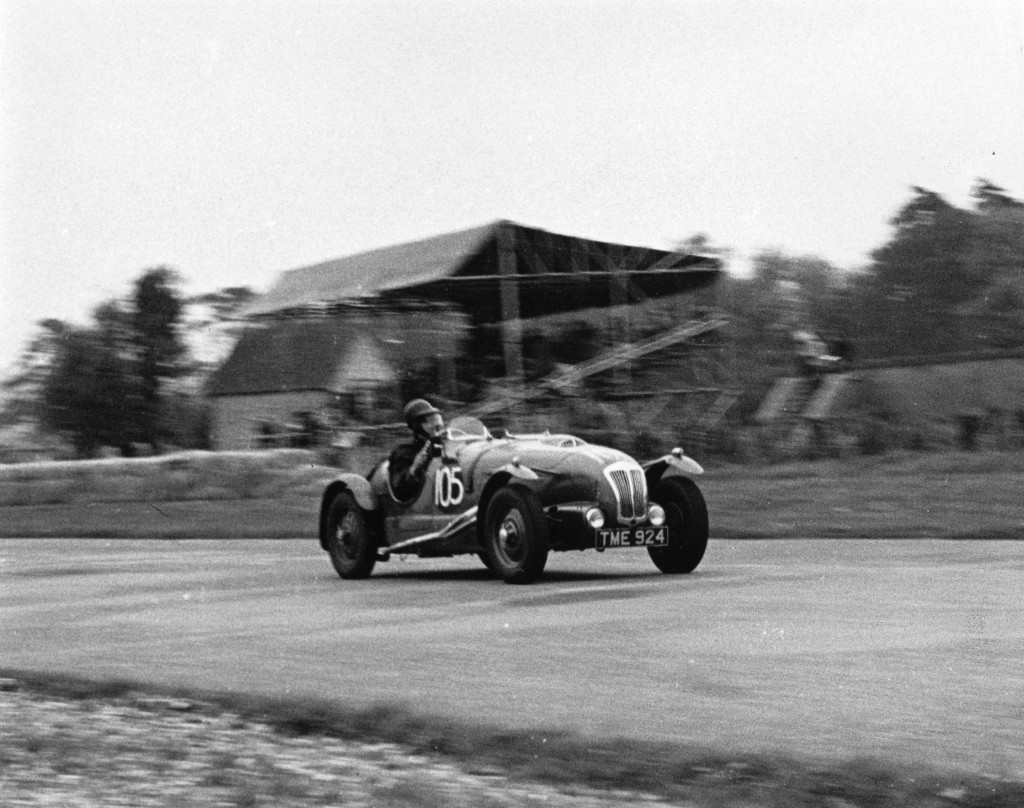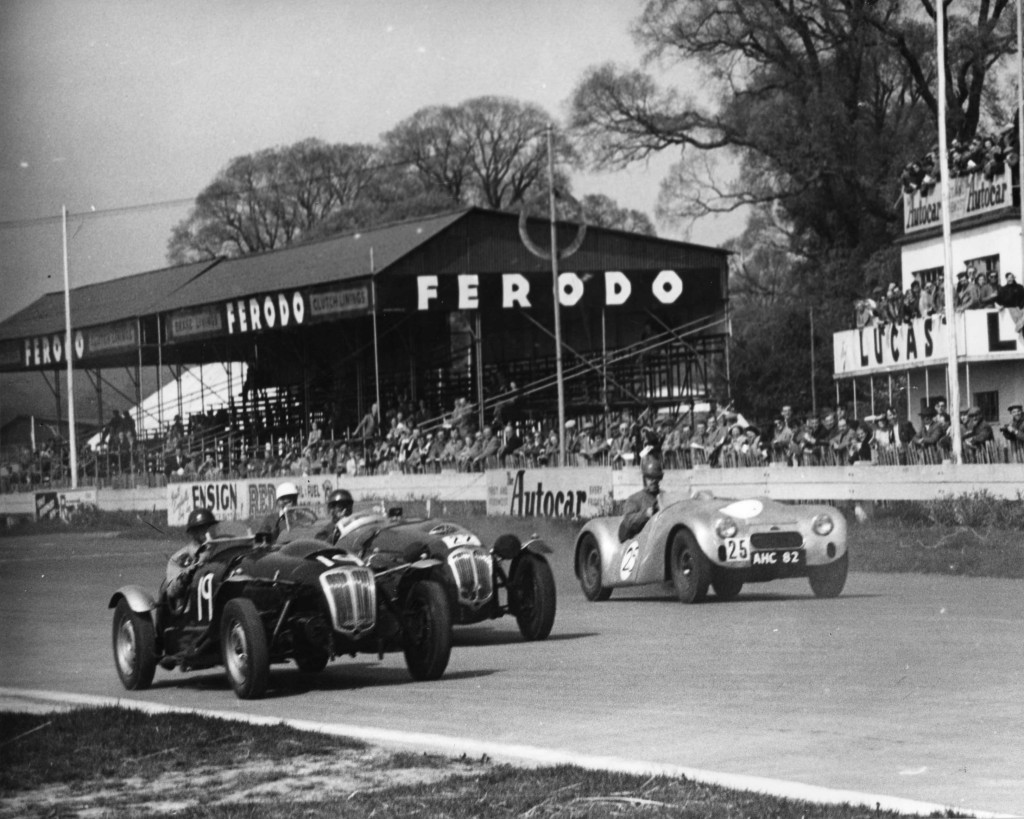
TME 924 was the sixth car to be produced by the Falcon Works at Isleworth and the second Competition model.
Built and registered in October 1948 (for some reason Ratty tells everyone that 1948 was a very good year!) it was the works development car and following a visit to the Falcon Works factory by Count ”Johnny” Lurani and Italian ex-motorcycle champion Dorindo Serafini in March 1949 it was agreed that the car would be used by team Scuderia Ambrosiana for Serafini to drive in the Giro de Sicilia (Targa Florio) in a few days time. The car was hurriedly painted green (the paint was not entirely dry on the ferry) and was driven down to Sicily by Serafini (no fancy trailers in those days).In very wet conditions with co-driver Rudi Haller the car started exceptionally well and led the field.

The course was lined with enthusiastic spectators, many of whom stood in the middle of the road, so cars were often confronted with a sea of people which parted at the very last moment. Archways of lights were set-up across the road and in villages the arrival of a car was signalled by letting-off a small mortar bomb. If a number of cars arrived at a village together the noise was considerable.
The following is an extract from Autocar March 25th 1949:-
A British contender for first honours in the sports category, the Frazer Nash shared by Serafini and Rudy Halller, had even worse luck than the Bristol. At Agrigento this car which had been hurriedly assembled in order to compete, was at the head of the great rain lashed procession, and again at Enna, Gela and Ragusa the Frazer Nash retained its ascendancy. Then Serafini skidded and struck a kerb, bending a front wheel and upsetting the steering. This calamity enforced the Frazer Nash’s retirement but not before it had qualified for the coveted Trophy of the Temples, put up for the best performance over an exceptionally difficult hill-climb section near Agrigento.
It had led for the first 400 miles. The reference to the car being assembled in a hurry probably means prepared in a hurry because the loan was agreed at very short notice. The collision with a kerbstone resulted in a buckled wheel and broken steering arm.
The main consideration of Serafini and Haller was to get the car back to Palermo because they knew that HJ “Aldy” Aldington the factory owner who was competing in the same race in a Bristol would be worried. They set about making temporary repairs to get the car to a garage and when they got it there it took several hours to make the car drivable. By now it was 16 hours since they started and they then drove through 200 miles of rain and snow over the mountains. When the temporary repair eventually failed and the car was once again un-driveable they found a lorry and hoisted the car up by some means and arrived back in Palermo at 8am some 28 hours after the start!
The car was driven back from Sicily to the Falcon Works for repairs and preparation for the Mille Miglia in April.

This time, for the Mille Miglia, it was driven to Brescia in Italy in a convoy of three cars, the other two being HJ Aldington and his wife Ivy in a Bristol 400 with an engine man from Bristol as a passenger, Chassis No 8 the Culpan car driven by Dickie Stoop with young John Aldington as passenger and TME 924 driven by Ronnie Hovenden the Works Manager and HJ’s nephew Tim as passenger.
The Culpan car had previously had over-heating problems and Dickie Stoop decided to see if these had been solved on the way to Brescia by participating in an enthusiastic run near St Dizier. Unfortunately the car hit a rock which was lying in the road at over 100mph and the car went into a long and lurid slide, went off the road and rolled over. John and Dickie were still in the inverted car which fortunately was straddling a ditch but they couldn’t get out. John’s parents had seen the accident and screeched to a stop. HJ forgot to apply the hand brake and the Bristol started to roll away with the distraught Ivy Aldington who didn’t drive and didn’t know how to stop the car. HJ instinctively grabbed the nearest part of the Frazer Nash to try to turn it over but this was the exhaust pipe and he badly burned his hands. Ronnie Hovenden arrived in TME924 and ran after the Bristol to bring it to a halt and people materialised as if from nowhere and righted the crashed car.
Both John and Dickie were generally unhurt and both were offered brandy to calm their nerves. Dickie who was staunchly tea total had a supply of his favourite Kia-Ora orange drink which he proceeded to consume while John looked on in envy as well-meaning locals pressed medicinal brandy on the fifteen year old.
When all was sorted out a plan was made for the damaged car (still a runner but somewhat knocked-about) to be sedately driven back to the factory by Ronnie Hovenden so that he could prepare it for Le Mans and the remainder of the party went to the start of the Mille Miglia at Brescia.

TME 924 was forced to retire at the halfway point at Rome due to mechanical problems but was subsequently sorted-out and on the way back home they stopped at the scene of the accident and John was photographed in front of the rock and TME 924.

The Culpan car and TME 924 had identical engines with adjacent numbers FNS1/3 for the Culpan car and FNS1/4 for TME 924. Engine FNS1/4 was replaced by Lawrence Mitchell and has gone the way of all racing engines and no longer exists, however FNS1/4 has remarkably survived (this is the engine that came third at the 1949 Le Mans 24 hour race!) and it is part of the Twirp collection and it may, one day be installed in TME 924.
These engines produced about 125bhp and the competition cars weighed less than 15cwt (750kg) which gives a power to weight ratio of around 166bhp per tonne which is about the same as a 1971, V12 Series 3 E Type Jaguar so you can see how competitive these cars were in period.
TME 924 was sold in June 1949 to Commander Allison of Halfway Garage for delivery to Patrick Hall who raced it at least once at Silverstone and also loaned it to Bob Gerard who drove it in the Daily Express Production Car Race at Silverstone in August of that year.



In early 1950 the car was sold to Tony Crook who raced it regularly having painted it red: races included Blandford and Goodwood in May, Silverstone in January and July, the Dundrodd TT in September and Castle Combe in October where he raced against Stirling Moss who was in a similar car.




In mid-1951 the car was sold to Lawrence Mitchell an ex-fighter pilot with extensive experience in Typhoons, Tempests and Spitfires who used the car, weather permitting, as his daily driver from Cheltenham to Birmingham and back. The roads were relatively free of traffic and speed limits were not yet in force so much of the journey was taken at racing speeds.
In his two and a half year ownership Lawrence Mitchell raced the car comprehensively at Silverstone, Goodwood (many races including the 9 hours twice), Castle Combe The Isle of Man (Empire Trophy) and Dundrodd.

During his ownership Mitchell agreed with Eric Storey of Bristol Cars that he would replace the engine with their latest high-lift cam engine. In 1952 following a shunt, it was converted by AFN to standard Le Mans Replica front suspension including telescopic shock absorbers and the front bodywork was also altered. An Austin rear axle was fitted together with bolt-on wheels and a modified rear body work.



Mitchell sold the car to Peter Scott –Russell in April 1954 and he owned it until March 1955 during which time he raced it at The Isle of Man, Ibsley, Davidstow, Silverstone, Castle Combe, Crystal Palace, Goodwood, Aintree and Snetterton.
Advertised in March 1955 Autosport, it was purchased by AD Brooks of Cambridge who raced it in a few club races before selling it to Tom James of RAF Duxford who after a couple of sprints sold it through John Aley to John Bain. Bain had a fatal accident at Charterhall and the wreck was bought by Clive Bourchier who rebuilt it with a swallow Doretti body and a side valve Mercury V8. It was bought by Stephen Curtis in October 1965 and rebuilt as a Le Mans Replica using the original chassis, a Bristol engine and a body by Crosthwaite and Gardiner. On completion of the rebuild in 1976 it was bought by Peter Jackson in 1977 who fitted it with an ex Bob Gerard 6 port head.
Peter Jackson sold the car to Harrogate Horseless Carriages in April 2004 who put the car into the H & H Auction in Buxton.
Ratty, being curious couldn’t resist just popping-in to the auction viewing day since he just happened to be passing, after all it’s not often that cars like this come up for auction.
TME 924 stood out with a totally irresistible “come hither and try me” look but Ratty being made of stern stuff was able to resist temptation, even after looking at the delicious comprehensive history in the document room.
Taking one last final lingering look, the Auctioneer enquired whether Ratty was going to attend the Auction. On hearing a negative response the (by now slightly annoying) auctioneer slid a bidding form across to Ratty and suggested he leave a bid. Ratty explained (protested?) that any bid would be well below their expectations only to be told that “a bid is a bid” (deeply philosophical, these auctioneers) so a suitably modest figure was scribbled on the bidding form and the matter forgotten.
Two days later Ratty’s phone rang. It was a certain Mr Simon Hope (the Auctioneer) congratulating him on his purchase! (Ratty will be forever indebted to Mr Hope for his tenacity!).
The car has been rebuilt yet again but this time by Blakeney Motorsport with meticulous attention to detail and returned to its original low headlamp specification as it was when it competed in the Giro de Sicilia in 1949.
It has regular outings at Harewood Hill Climb and elsewhere and regularly appears in Twirp tours.


